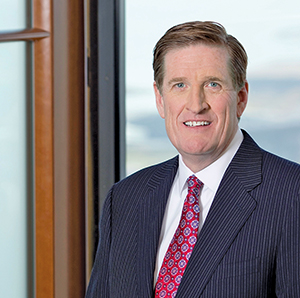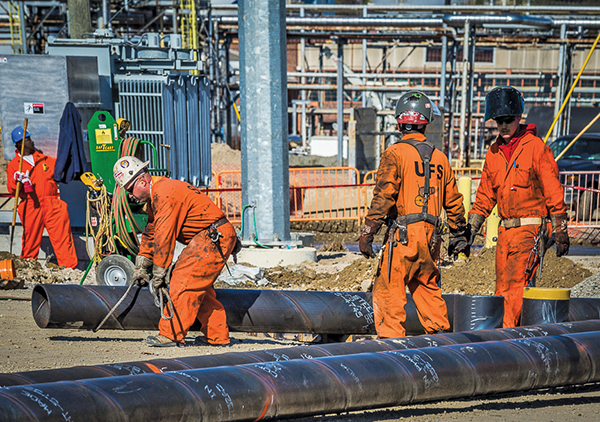Three decades ago, the Philadelphia 76ers were known as a team that could beat you any way they wanted on the basketball court: inside, outside, with slick moves or with brute force.
From the high-flying dunks of Julius “Dr. J” Erving to the outside shooting of Andrew Toney, the 76ers of that era regularly dominated opponents in the National Basketball Association.
Flash forward to 2016 and Philadelphia wants to be a leader again — but in an entirely different arena: the global energy business.
From record-breaking investments into new gas pipelines to enhancing the largest oil refinery complex on the East Coast, the Greater Philadelphia region is positioning itself to be the next “Global Energy Hub,” according to a coalition of community and business leaders who are committed to this cause.
Matt Cabrey, executive director of Select Greater Philadelphia, says that the Greater Philadelphia Energy Action Team (GPEAT) is an initiative of the Greater Philadelphia Chamber of Commerce to lead the region toward carving out a globally relevant leadership position in energy.
“Our focus is to create this energy hub,” he says. “We have very strong infrastructure assets. We are exceptionally well positioned with our transportation network, particularly with our railroads, highways and seaport access. The international airport is also a significant factor. These unique assets form a core foundation for continued growth across our region.”

That foundation is made of multiple components — oil refineries; massive oil and gas pipelines; gas distributors; and a political and legal framework designed to bolster these industries and their byproducts.
Denis O’Brien, Senior Executive Vice President, Exelon and CEO, Exelon Utilities, and chairman of the Chamber, says that “the collaboration of the business and political community is as positive now as it has been in the past 20 years.”
With three refineries along the Delaware River and the prospect of three major pipelines being extended all the way from Western Pennsylvania to Delaware County and south Philadelphia, conditions are ripe for the region to take the next step as a globally competitive energy resource provider, O’Brien notes.
“Our region is positioned with abundant natural gas, and current pricing is extremely favorable,” O’Brien says. “Everybody in the region is focused on this opportunity, and working together to enable additional pipeline development.”
Piping in the Solution
Sunoco Logistics is leading the charge to bring additional pipeline access to the region. Mariner East 1 is a 300-mile-long pipeline project that was recently completed by Sunoco Logistics. It stretches from southwest of Pittsburgh to the Marcus Hook Industrial Complex in Delaware County, Pa. The new pipeline began distributing propane in December of 2014 and added ethane shipments in January 2016. It is capable of delivering both ethane and propane to the region.
Sunoco Logistics continues to work on Mariner East 2, a 350-mile-long pipeline that extends from Eastern Ohio to Marcus Hook. An additional pipeline known as Mariner East 2X is now in open season, meaning that various shippers are in negotiations for contracts with the pipeline operator. A recent study by Econsult Solutions of Philadelphia found that the estimated economic impact of the various Sunoco Logistics pipeline projects will be $4.2 billion, with more than 30,000 jobs generated during construction.
Jeff Shields, communications manager for Sunoco Logistics and Sunoco Inc. in Newtown Square, Pa., says that 70,000 barrels of liquid gas a day is the capacity of ME1, while ME2 will have a capacity of up to 700,000 barrels a day. “There are two planned off-takes along the way,” says Shields. “They are in Lebanon County and Berks County. Propane offloading points will be there for local delivery. That will make a big difference in the winter months. Some 190,000 homes in Pennsylvania are heated during the winter with propane. Farmers also use it to heat their livestock sheds and dry out their crops.”
Ultimately, the new pipelines will be used to distribute ethane, butane and potentially a light form of oil, Shields adds. “We are actively pursuing a propane processing complex, known as a propane cracker,” he says. “You take propane and turn it into propylene, a building block for all kinds of materials such as plastics, fabrics, detergents, etc.” The propane cracker alone represents an additional capital investment of $1 billion to $1.5 billion, according to one study.
Another key player in the region’s energy economy is Philadelphia Energy Solutions, which processes 335,000 barrels of crude oil a day, making it the largest refinery operation on the East Coast.

Phil Rinaldi, CEO of PES, says that “the idea of Philadelphia as an energy hub is really a question of the Marcellus Shale natural gas resources. It is about taking advantage of those resources — both in dry gas form [methane] and wet gas form [propane and butane]. With the Marcellus and Utica shale plays, this is the most prolific natural gas region in the nation. The reserves exceed well over 100 years.”
All that’s needed is to tap it and use it, Rinaldi says. “The existing market for the gas is at a limit. It is constrained by the market for the gas,” he says. “If you have new markets, you must have new customers. Philadelphia is uniquely positioned to provide that. It is the center of mass for the refining industry on the East Coast. We have the population. We have the Delaware River. We have the CSX and Norfolk Southern railroads. And now we have great pipeline access.”
Being an energy hub is not just about distributing energy, Rinaldi notes. “It is about fulfilling our historic role as a manufacturing center,” he says. “There is a pro-manufacturing mentality here. The skill level of manufacturing workers in this region is extraordinary. If you can create new factories that will rely on the use of natural gas as a feedstock, then this is the place to build. We are talking about moving the wellhead into Philadelphia and unlocking the full manufacturing potential of this region.”
Gas Firms Work Together
Others who belong to the GPEAT coalition agree. John Walsh, president and CEO of UGI, a global, multi-faceted energy company headquartered in Valley Forge, Pa, says that more industrial customers are looking to access natural gas every day. “The demand is moving fluidly upward,” he says. “We have historically low costs for natural gas and natural gas liquids. The price of propane is lower than it has been in over a decade. There is increased demand for natural gas to replace coal as the feedstock for electric power plants.”
About a year ago, UGI announced a major new pipeline from northeastern Pennsylvania into New Jersey. “This is the $1.1-billion Penn East Pipeline that will carry Marcellus gas into New Jersey,” says Walsh. “It is a great partnership of four major gas companies in the region. We are working together to ensure a long-term solution for moving large quantities of Marcellus gas to our customer base.”
If everything goes as planned and the project secures all its needed federal approvals, the new pipeline should be operational in 2019, Walsh says. “What we want everyone to know is that there is a great commitment to collaboration among the businesses and the public sector in Pennsylvania and especially in Philadelphia. We work together to make sure that we build out the needed energy infrastructure.”
Craig White, president and CEO of Philadelphia Gas Works, says that bringing more natural gas into the Greater Philadelphia region is one of the chief needs. “PGW is planning with the Mayor to expand our LNG [liquefied natural gas] assets,” he says. “We have test-driven the market with multiple years of LNG sales in the interruptible LNG marketplace. With this experience and with the growing demand for natural gas, it is readily apparent to us that there is a significant need for additional LNG, and it is our goal to meet that need.”

White says he sees multiple new sources of demand for gas in the near future. “The development of combined heat and power is one emerging trend,” he notes. “This is a form of distributed generation using natural gas. You create electricity, and with the waste heat you can heat up your building and install absorption chilling. It is 65 to 80 percent efficient. It is much more efficient than using steam.”
White also sees compressed natural gas being adopted by more fleets. “If you are going to attract manufacturing to the city in the future, you have to do that,” he says. “You have to replace gas-powered vehicles with CNG. PGW has some CNG vehicles. Temple University uses them. But most major fleets have not yet gone in that direction. It comes down to dollars and cents. It requires an investment.”
White says PGW will issue its RFP soon for developing its LNG facility. “With Board approval, PGW will issue a Request for Proposal [RFP] soon for the purpose of increasing our LNG capabilities,” White says. “Timing is key for maximizing market opportunities and PGW is poised to advance the ball quickly.”
Law Firms Support Process
Law firms in the region are part of the GPEAT coalition as well. Marc Gold, partner with Manko Gold Katcher Fox LLP, says that “we have a mix of clients involved in direct and indirect operations relating to the energy industry. We represent a lot of companies that are interested in selling and developing property. One issue is the appropriate re-use of former industrial properties. A large part of my work is how we attract developers and businesses to properties that are suitable for development.”
For this to happen, notes Gold, “we need to have the ability to get the gas here. The constraint is not on the production end. It is how to get the gas from where it is extracted to where it can be used. Among the fossil fuels, natural gas is among the most environmentally friendly. The Federal Energy Regulatory Commission is reviewing and approving natural gas pipelines because they understand that this is the best option and the pipeline construction can be done in an environmentally responsible way.”
The big payday at the end of this effort is the boon to the tax base that will occur from a manufacturing renaissance in the region, says Gold.
“People should be excited about the prospects here,” he adds. “The prospects of low energy costs and low costs of materials are big factors in site selection. Those are leading-edge issues. All of this will only make the Philadelphia region more attractive in the future.”
Cristina Jorge Schwarz of environmental firm Apex Companies LLC says that a core focus of GPEAT is to raise global awareness regarding the favorable location and assets of the Philadelphia region.
“We have done a great job inviting companies to come here and look,” she says. “Now, we need to reach out to companies that may not know us yet and let them know that it is a great time to invest here. We have the available land, the skilled labor, the top-notch universities, a great transportation network, cultural diversity and a robust energy infrastructure. We are leveraging our greatest strengths in the region, and the business community in all 11 counties has come together. We have made a commitment to the region to support the creation of this energy hub.”
O’Brien of Exelon echoes that sentiment. “The place to live right now is Philadelphia,” he says. “We are on the brink of something really great. As we continue to figure out how to harness the power of this energy opportunity, there will be no stopping this region.”
That’s what they said about Dr. J and the 76ers more than 30 years ago. That Philly team rode its momentum all the way to a four-game sweep of the Los Angeles Lakers in the NBA Finals in 1983.
Today, the leaders of GPEAT are engaged in a full court press to transform Greater Philadelphia into the next global energy hub.
This Investment Profile was prepared under the auspices of Select Greater Philadelphia. For more information contact Jeanne Nevelos at 215-790-3726 or jnevelos@selectgreaterphila.com. On the Web, go to www.selectgreaterphiladelphia.com.

